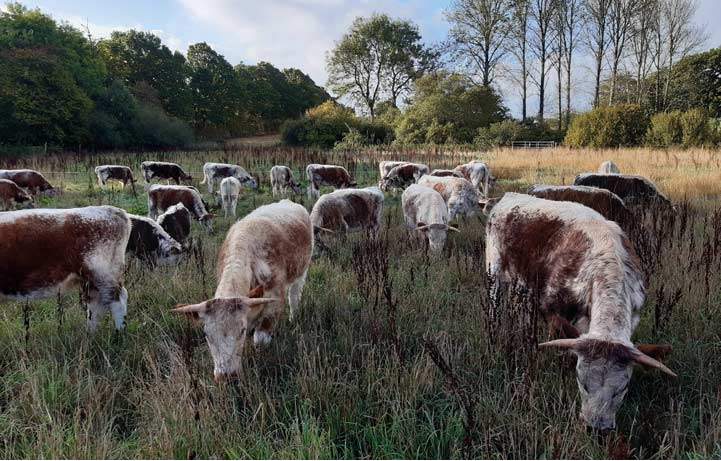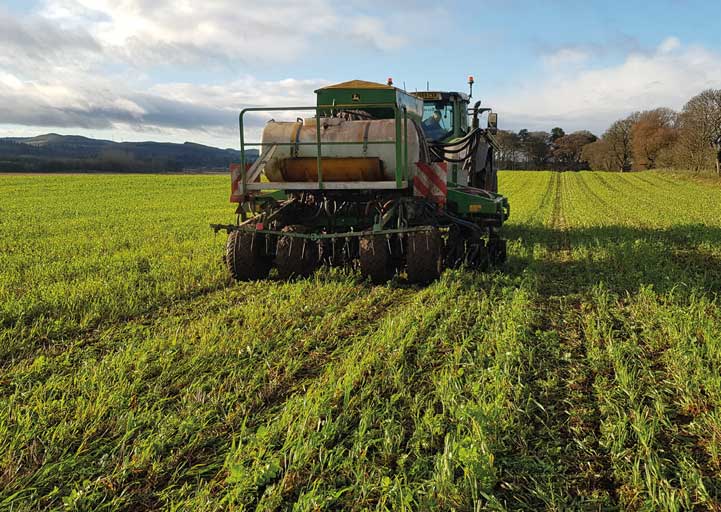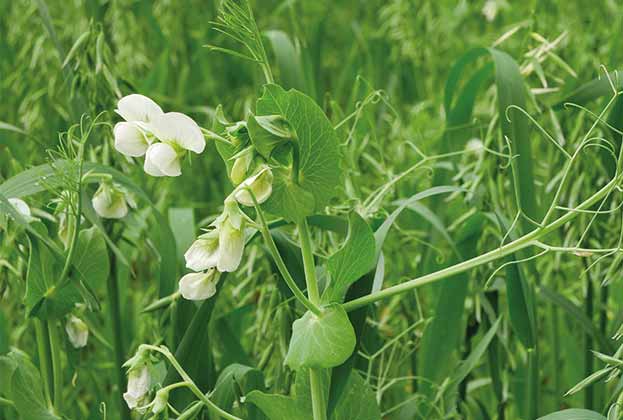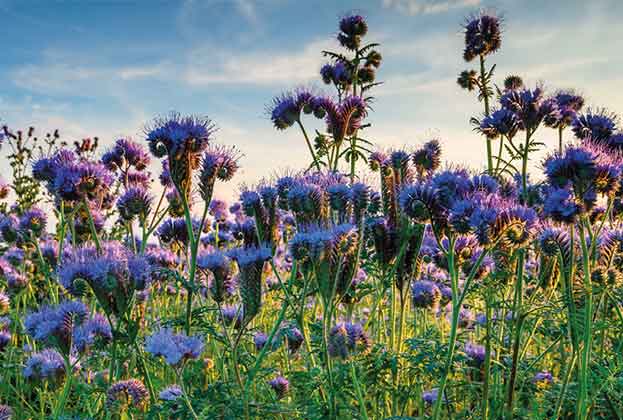Molly Biddell interviewed Russ Carrington, who is leading Knepp Castle Estate’s new vision of a regenerative agricultural enterprise to sit alongside its rewilding venture

Russ Carrington
Knepp Castle Estate in Sussex may be best known for its rewilding success story, but it is also pioneering in adopting another vision. Around 150 hectares of the estate are in the process of being converted into a new regenerative agriculture enterprise. The venture will largely be grassland-based and, over time, it will integrate complementary livestock enterprises; starting with 100% pasture-fed beef cattle, followed by poultry and, as momentum builds, a micro-dairy and pig enterprise. In preparation, fences, water supplies and tracks are being installed.
The project has three core aims. The first is to explore nature recovery on a landscape-scale by coordinating management practices between adjoining land parcels, working with neighbouring farmers and linking up patchworks of rewilded and agricultural land within the River Adur catchment. This landscape approach will benefit from collaboration through the local farmer facilitation group and is aiming to be aligned with the proposed third tier of the future Environmental Land Management (ELM) scheme.
The second aim is to investigate the ability of regenerative agriculture techniques to build natural capital by measuring changes taking place on the land over time. Key ecological indicators will be monitored at eight different locations across the new farm. These indicators are soil health (including soil carbon), flora and fauna (populations and species diversity) and water quality. Alongside this, a detailed habitat map will be created and a carbon account kept to record carbon sequestration, emissions and storage. The monitoring process, which will involve detailed on-the-ground assessments and testing, will be supported by additional scientific analysis.
The third aim is to supply nutritious, low-carbon, sustainable food through a planned Knepp farm shop and café. The farm shop will be a gateway to the estate and will sell meat from both the free-roaming animals within the rewilding project and produce from the regenerative farm. The meat sold from the regenerative system will be Organic and Pasture For Life Certified – Russ stresses the importance of communicating product provenance to society. There are also plans to create a market garden next to the farm shop to supply fruit and vegetables. Increasing public access and engagement through these symbiotic enterprises is an important part of the estate’s overall strategy, and the social impact will also be benchmarked.

Russ is transparent in explaining that, with declining Basic Payment Scheme (BPS) payments, the model relies on being able to tap into Countryside Stewardship and future ELM income or alternative private funding for ecosystem services, despite uncertainty around exactly how that might materialise.
Russ believes regenerative agriculture will be pivotal in the future of our food production. He explains that this is because the sum of regenerative agriculture is greater than the sum of its parts and the approach can not only heal earlier ecological damage, but also increase the land’s overall fertility and productivity.
So why isn’t everyone already on the regenerative journey? Russ believes that the main hurdles preventing farmers from adopting more regenerative practices are mind-set, a lack of certainty around future agricultural policy and the knowledge and skills gap that needs to be filled to promote regenerative models.
Russ Carrington is on Twitter @CiderRuss

Prioritising soil health is the key to the future of farming
The result: more resilient crops that need fewer inputs
James Hopkinson is the founder of Cloud Farming, a farm management business that provides low cost and adaptable alternatives to conventional farming. Cloud Farming work with both James’ family farm Lindertis and Walker-Munro Farms. They work in partnership with Arable Ventures, who provide the technology, equipment and labour to the farming operations in Angus, Scotland.
With over 600 hectares of arable land, Walker-Munro Farms has been moving towards regenerative agriculture for the past four years. The soils on the farm range from light sandy loams to heavy silt and clay loams. Previously, the farming operations centred around conventional ploughing and power harrowing. But in 2017, the farm needed to cut its input costs in order to remain viable, and James became interested in the benefits that direct drilling and other regenerative methods could offer to the farm business. The farm moved way from full inversion tillage to non-inversion and shallow scratch tillage, cutting its fuel and labour costs. Moving to a regenerative model required some compromises – one of the biggest being not growing potatoes as deep cultivations do not fit with James’ no-till vision. The farm now grows winter wheat, spring barley, winter barley, oats, peas, linseed, beans and grass in a wide rotation.
Adopting a regenerative model takes time, it’s not an overnight system change, but it’s incredibly rewarding, and it’s the future of resilient farming
James Hopkinson, Cloud Farming
For James, prioritising the soil is the obvious way to approach farming. He keeps soil under stubble and grows cover crops, grazing them where suitable. He has conducted grazing trials on his winter cereals, which he hopes will allow him to cut back on chemical spend, while increasing soil fertility. Manure is put back on the land via a straw for muck exchange.
By focusing on plant health through an integrated pest management system, James hopes to continue to reduce the amount of nitrogen fertilisers, herbicides, fungicides and insecticides he needs to apply, understanding that soil health is paramount to a less reliant, more resilient crop. The farm is using gamma radiation mapping to better monitor and understand changes in soil health. Over the past four years, James has seen huge improvements in the soil structure and the switch to no-till and scratch tillage has not impacted his crop yields.
James loves the fact that there is no handbook for regenerative agriculture – for him it requires a change in mindset and drive. Learning from other farmers and farm visits have been important for him in his regenerative agriculture education. He explains adopting a regenerative model takes time, but it’s incredibly rewarding, and he believes it’s the future of resilient farming.
James Hopkinson is on Twitter @arableventures
Increasing profitability at Gowbarrow Hall Farm
Gowbarrow Hall Farm in the Lake District is run by the Beaumont family and has been farmed regeneratively for the past two years. Previously, it was a traditional upland sheep farm, but the family realised they were making very little profit from the conventional production system.
They sold the sheep and started building a herd of shorthorn cattle, rearing them on a 100% pasture-fed grazing system and keeping them outdoors all year round. There are now 50 head of cattle and the herd is expanding. Sam Beaumont explained that this new approach works really well with the land that they have, as they are able to mob graze the lower meadows during the summer and then send the cows up on to the top fells to roam extensively during the winter. This is inspired by the concept of Wilderculture, and creates a hybrid regenerative-rewilded model, which works within the natural perimeters of the landscape, making the most of its natural variety.
The greatest success of the farm’s transition has been the substantial reduction in input costs. The only external input for feed over the past year has been three bales of hay. They have removed overheads such as indoor housing and veterinary costs – the cows’ overall health has improved since being outdoors all year, with fewer cases of problems such as lice and calf pneumonia. The farm sells the beef at a premium price from the freezer direct to customers, with UK-wide delivery proving a great success during the Covid-19 pandemic.
Sam Beaumont explains that adopting this new system hasn’t increased productivity but has definitely increased their profitability. He recommends starting small and scaling up, saying “no one-size-fits-all” and that it is important to work out what will suit you and your land best.
Gowbarrow Hall Farm is on Twitter @gowbarrow
Read the articles within Spotlight: Regenerative agriculture below.
.jpg)

